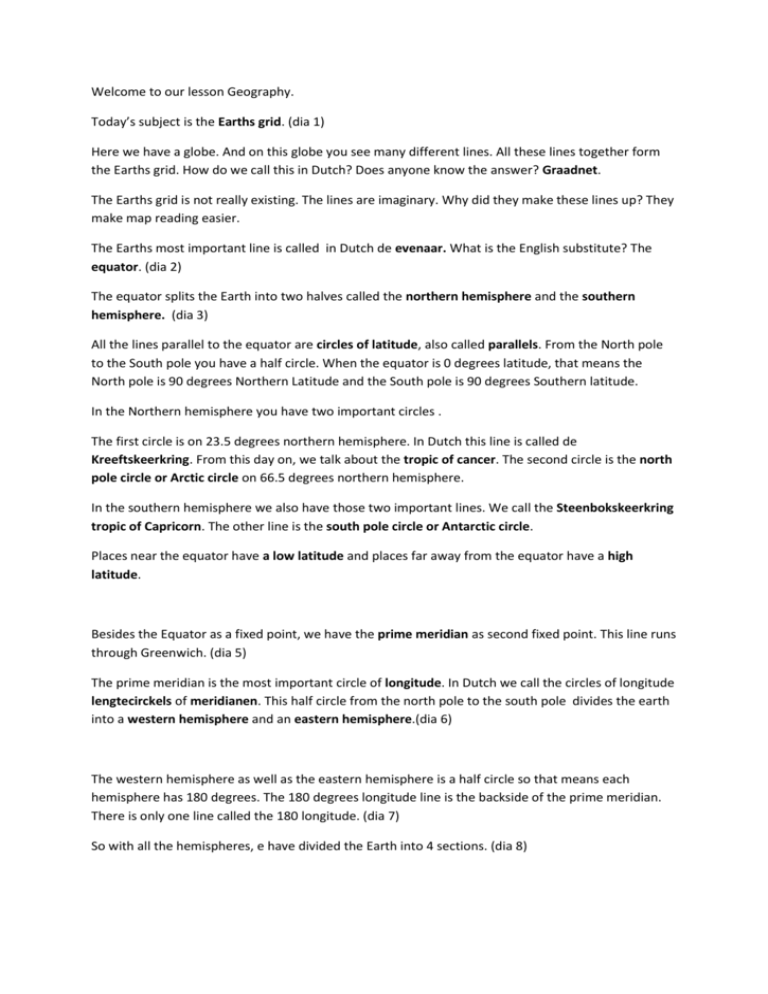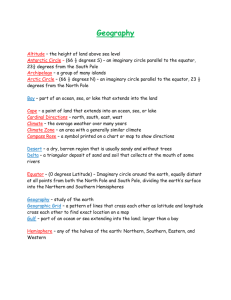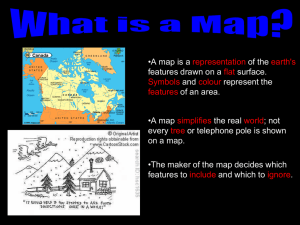World Longitude and Latitudes Map
advertisement

Welcome to our lesson Geography. Today’s subject is the Earths grid. (dia 1) Here we have a globe. And on this globe you see many different lines. All these lines together form the Earths grid. How do we call this in Dutch? Does anyone know the answer? Graadnet. The Earths grid is not really existing. The lines are imaginary. Why did they make these lines up? They make map reading easier. The Earths most important line is called in Dutch de evenaar. What is the English substitute? The equator. (dia 2) The equator splits the Earth into two halves called the northern hemisphere and the southern hemisphere. (dia 3) All the lines parallel to the equator are circles of latitude, also called parallels. From the North pole to the South pole you have a half circle. When the equator is 0 degrees latitude, that means the North pole is 90 degrees Northern Latitude and the South pole is 90 degrees Southern latitude. In the Northern hemisphere you have two important circles . The first circle is on 23.5 degrees northern hemisphere. In Dutch this line is called de Kreeftskeerkring. From this day on, we talk about the tropic of cancer. The second circle is the north pole circle or Arctic circle on 66.5 degrees northern hemisphere. In the southern hemisphere we also have those two important lines. We call the Steenbokskeerkring tropic of Capricorn. The other line is the south pole circle or Antarctic circle. Places near the equator have a low latitude and places far away from the equator have a high latitude. Besides the Equator as a fixed point, we have the prime meridian as second fixed point. This line runs through Greenwich. (dia 5) The prime meridian is the most important circle of longitude. In Dutch we call the circles of longitude lengtecirckels of meridianen. This half circle from the north pole to the south pole divides the earth into a western hemisphere and an eastern hemisphere.(dia 6) The western hemisphere as well as the eastern hemisphere is a half circle so that means each hemisphere has 180 degrees. The 180 degrees longitude line is the backside of the prime meridian. There is only one line called the 180 longitude. (dia 7) So with all the hemispheres, e have divided the Earth into 4 sections. (dia 8) Assignment 1 (dia 9) 1. Each of you will get a balloon. Blow this balloon up to a large size. On this balloon you will draw the most important lines of the Earths grid, you've just heard from us. You have to draw at least seven lines and the north and south pole. 2. I am going to give you five names of cities. You have to point them in the right place on your balloon. (dia 10) a. Amsterdam b. New York c. Cape town d. London e. Rio de Janeiro Geography Test about the Earths grid: http://members.shaw.ca/len92/geography_test2.htm World Longitude and Latitudes Map Using the world longitude and latitude map printout, answer the following questions and mark the locations. 1. Draw a line along the equator (0 degrees latitude) and label it. 2. Draw a line along the Prime Meridian (0 degrees longitude) and label it. 3. In which ocean is the location 10 degrees S latitude, 75 degrees E longitude located? Mark it on the map with an "X" and write the name of the ocean. 4. In which ocean is the location 30 degrees N latitude, 60 degrees W longitude located? Mark it on the map with a "Y" and write the name of the ocean. 5. Put an "X" on the following cities on the map and label the city with the name of the city. B. Beijing: 40°N, 116°E C. Cairo: 30°N, 31°E H. Hong Kong: 22°N, 114°E J. Jakarta: 6°S, 106°E LO. London: 51°N, 0°W MC. Mexico City: 19°N, 99°W MO. Moscow: 55°N, 37°E NA. Nairobi: 1°S, 37°E NO. New Orleans: 30°N, 90°W NY. New York: 40°N, 74°W R, Rio de Janeiro: 23°S, 43°W SE. Seattle: 47°N, 122°W SY. Sydney: 34°S, 151°E TK. Tokyo: 35°N, 139°E T. Toronto: 43°N, 79°W









